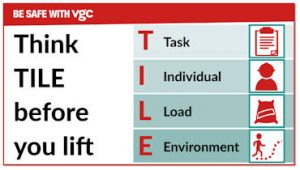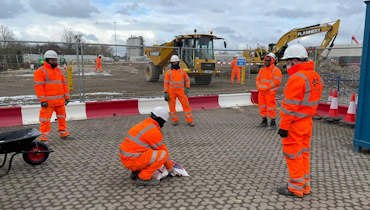I have been giving face-to-face manual handling training to operatives on HS2 over the last few weeks.
This is part of our partnership on the SCS labour desk, working with other labour suppliers McGinley and Danny Sullivan.
I visit people at their place of work, to make sure they are lifting safely, looking at the work activities they carry out daily. By visiting people on site I can look at what they are actually doing. This is a good counterpart to training courses in a classroom.
Training is carried out in small groups to ensure social distancing. Having fewer people makes it easier for everyone to see and hear.
I start with a briefing, explaining the importance of safe lifting, and then I describe safe lifting techniques.
The training session includes causes and types of injuries from poor manual handling, and what to do if you do injure yourself while carrying out a task. it is important to use correct manual handling techniques at home as well as at work.
 Lifts all start with TILE:
Lifts all start with TILE:
- Task
- Individual
- Load
- Environment
I explain that we should try to eliminate the need to lift items by designing out manual handling operations. We reduce the risk of injury by using mechanical means such as cranes or forklifts for a task.
The next step, if this is not possible, is to use aids such as wheel barrows and pallet trucks. Remember, this still is a form of manual handling, so still needs care and correct technique.
Only manually handle a load by lifting and carrying if you absolutely have to.
I brief the team on the controls before a lift should take place. The training itself is a form of control, because they are being taught the correct methods of lifting. We also discuss team lifting to reduce load weight, and job rotation to reduce fatigue. I remind them to take regular breaks if the task is repetitive.
As part of the training sessions I also remind operatives to stop work and tell their supervisor if they do not have the correct training for any task, feel unsafe, or are unable to carry out a task for personal reasons, such as medical history and illness. No-one will ever be penalised for raising a safety concern. If anyone feels pressured into an activity, they should speak to the HSQE safety team.
 Then we create a relevant lifting activity, with items which are lifted regularly on site. First I select one of the items in the area and demonstrate safe lifting technique.
Then we create a relevant lifting activity, with items which are lifted regularly on site. First I select one of the items in the area and demonstrate safe lifting technique.
- Assess load
- Stable position, close to load
- Bend knees, back natural position
- Good grip
- Look forward
- Lift with legs, not back
- Carry load close to body at waist height
- Look ahead when walking
- Do not twist when lifting or carrying.
The steps are reversed when placing down.
Then I assess each individual’s lifting. If I see someone attempting to lift incorrectly, I step in and stop the lift. I discuss their technique and explain where they were going wrong. Then I ask the person to lift again, either praising a safe lift or giving more guidance until I am happy.
 As part of the training session, I also discuss the risks of bad manual handling, and how it can affect both their home and work life. Back injuries can have long-lasting negative effects. People usually are off work for a considerable time – and SSP is not a lot of money. Using the safe lifting techniques and training we have been through will help reduce the risk of these injuries.
As part of the training session, I also discuss the risks of bad manual handling, and how it can affect both their home and work life. Back injuries can have long-lasting negative effects. People usually are off work for a considerable time – and SSP is not a lot of money. Using the safe lifting techniques and training we have been through will help reduce the risk of these injuries.
I feel that the workforce welcomes the on-site training: they listen and take in the information.
I will be attending site regularly and monitoring the work force on the project to ensure they are following the safe lifting techniques. It’s an important way to make sure everyone goes home safety after each shift.
